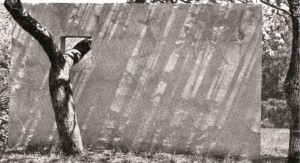”Is North-America inhabitable?” Rudofsky believed that the contemporary American house and lifestyle is wrong and suggested that comfort and human satisfaction had been sacrificed for the sake of modernism’s aesthetic and ideological aims. According to Rudofsky, the amenities of modern life have fostered the belief that we have conquered the inconveniences of our climate.
He was concerned with the adoption of an architectural model founded on the principle of indoor-outdoor living, which he suggested was an oxymoronic expression of cultural self-deception. It is emphasized with the example of Plymouth Plantation as a penal colony. “The hostile environment and climate did not encourage an intimate relationship between man and nature; the soil did not hold a mystical attraction to the settler.” He stated that white man failed to produce anything revolutionary or particularly ingenious in America. Additionally, their efforts were more toward maintaining a tolerable indoor temperature instead of habitable outdoor environments. In this point, he makes us think about the limits of climate control.
“Does climate control really end at the door step?”
He described the exposed living room of the modern American house as “the meanest sort of auditorium, unfit for conviviality.” Rudofsky criticized the contemporary garden as well, asserting that “no other civilization has produced gardens as melancholy as ours; aesthetics apart, our suburban front lawns and backyards are a gigantic waste of potential outdoor living space”.
Rudofsky argued, “like the parlor of our grandmothers, the garden is an object of excessive care. Like the parlor, it is not meant to be lived in.” Calling attention to the greater loss incurred with the commodification of the view, he proposed: “In an age that puts a premium on usefulness, this is most irregular. The ‘picture window,’ as the domestic version of the show window is called, has contributed to the estrangement between indoors and outdoors; the garden has become a spectator garden.”
Rudofsky states the differences of historical and modern gardens. Accordig to the text, domestic gardens in the past has the value of habitableness and privacy which are absent in contemporary gardens. He describes them as “rooms without ceilings” and “outdoor living rooms”. Another quality of historical gardens found in common: order, like absence of disorder. He argued “Vegetatiton alone, it seems, connot supply the commodiousness which makes a garden livable. It depends upon the presence of some inanimate elements: a gate, a bench, a few posts, which constitute, so to say, centers of gravity in an agitated sphere of forms and colors, sounds and smells.” Additionally, remains are another feature of historical gardens communicating a unique sense of comfort.
It is argued that fragmentary states of outdoor rooms is a permanent fixture of domestic architecture. As given the example of Pompeii, labyrinthine configuration of space in Pompeii is given as an example of positional relations: “indoors that reverted to outdoors; gardens of a poetic sort; opening and closing on ever new vistas.” These fragmentations are defined as room-like atmosphere. Their charm lies more in the robust interplay of wall surfaces, sunlight and vegetation. Walls have no any specific function. It is a piece of sculpture among trees and shrubs, not only contrast with nature but also changing spectacle of shadow and reflection. In addition to that wall is introduced as sense of order which makes the garden habitable. The wall in habitable gardens provides shade, braves the wind, cushions noise, defies the beast and becomes art in garden. Enclosing walls in garden creates expansion rather than shrinkage. And every subdivision in gardens increases its surface.
As a conclusion, an outdoor space becomes a special outdoor room when it is well enclosed with walls of the building, walls of foliage, columns, trellis, and sky; and when the outdoor room, together with an indoor space, forms a virtually continuous living area.

